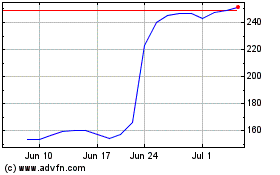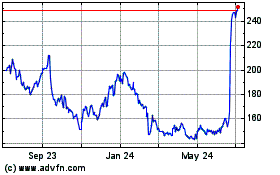− First Potential Treatment Demonstrating
Substantial Reduction in the Frequency of Porphyria Attacks –
Alnylam Pharmaceuticals, Inc. (Nasdaq: ALNY), the leading RNAi
therapeutics company, announced today the completion of the rolling
submission of a New Drug Application (NDA) to the U.S. Food and
Drug Administration (FDA) for givosiran, an investigational RNAi
therapeutic targeting aminolevulinic acid synthase 1 (ALAS1) in
development for the treatment of acute hepatic porphyria (AHP).
Givosiran previously received Breakthrough Therapy Designation from
the FDA and Orphan Drug Designation in the U.S. for AHP.
“We’re very pleased to have completed our NDA filing for
givosiran, just 90 days since reporting our positive topline
ENVISION Phase 3 study results, consistent with our commitment to
bring givosiran to patients as rapidly as possible. ENVISION
demonstrated that givosiran substantially reduced the annualized
rate of composite porphyria attacks, relative to placebo, with an
overall safety and tolerability profile that we believe is
encouraging in the context of this high unmet need disease,” said
Akin Akinc, Ph.D., Vice President and General Manager, Givosiran
Program at Alnylam. “Based on these results, we believe givosiran
has the potential to be a life-changing medicine for patients
living with AHP. With this submission, we are now one step closer
to achieving our goal of providing a new therapeutic option for the
treatment of AHP. We look forward to working with the FDA and other
global regulatory agencies to bring this medicine to patients.”
Givosiran has also been granted Priority Medicines (PRIME)
Designation by the European Medicines Agency (EMA) and Orphan Drug
Designation in the EU for AHP. Alnylam intends to file a Marketing
Authorisation Application (MAA) in mid-2019.
About Givosiran
Givosiran is an investigational, subcutaneously administered
RNAi therapeutic targeting aminolevulinic acid synthase 1 (ALAS1)
in development for the treatment of acute hepatic porphyria (AHP).
Monthly administration of givosiran has the potential to
significantly lower induced liver ALAS1 levels in a sustained
manner and thereby decrease neurotoxic heme intermediates,
aminolevulinic acid (ALA) and porphobilinogen (PBG), towards normal
levels. By reducing accumulation of these intermediates, givosiran
has the potential to prevent or reduce the occurrence of severe and
life-threatening attacks, control chronic symptoms, and decrease
the burden of the disease. Givosiran utilizes Alnylam’s Enhanced
Stabilization Chemistry ESC-GalNAc conjugate technology, which
enables subcutaneous dosing with increased potency and durability
and a wide therapeutic index. The safety and efficacy of givosiran
were evaluated in the ENVISION Phase 3 trial with positive results;
these results have not been evaluated by the FDA, the EMA or
any other health authority.
About ENVISION Phase 3 Study
The ENVISION Phase 3 trial was a randomized, double-blind,
placebo-controlled, global, multicenter study to evaluate the
efficacy and safety of givosiran in patients with a documented
diagnosis of acute hepatic porphyria (AHP). The primary endpoint
was reduction relative to placebo in the annualized rate of
composite porphyria attacks, defined as those requiring
hospitalization, urgent healthcare visit, or hemin administration
at home, in patients with acute intermittent porphyria (AIP, the
most common subtype of AHP) over six months. Key secondary and
exploratory endpoints evaluated reductions in neurotoxic heme
intermediates, aminolevulinic acid (ALA) and porphobilinogen (PBG),
usage of hemin, symptoms of AHP, such as pain, nausea, and fatigue,
as well as impact on quality of life. The trial enrolled 94
patients with AHP, at 36 study sites in 18 countries around the
world and is the largest ever interventional study conducted in
AHP. Patients were randomized 1:1 to givosiran or placebo, with
givosiran administered subcutaneously at 2.5 mg/kg monthly. Upon
completion of dosing in the double-blind period, all eligible
patients (99 percent) enrolled in the ENVISION open-label extension
(OLE) to receive givosiran on an ongoing basis.
About Acute Hepatic Porphyria
Acute hepatic porphyria (AHP) refers to a family of rare,
genetic diseases characterized by potentially life-threatening
attacks and for some patients chronic debilitating symptoms that
negatively impact daily functioning and quality of life. AHP is
comprised of four subtypes, each resulting from a genetic defect
leading to deficiency in one of the enzymes of the heme
biosynthesis pathway in the liver: acute intermittent porphyria
(AIP), hereditary coproporphyria (HCP), variegate porphyria (VP),
and ALAD-deficiency porphyria (ADP). These defects cause the
accumulation of neurotoxic heme intermediates aminolevulinic acid
(ALA) and porphobilinogen (PBG), with ALA believed to be the
primary neurotoxic intermediate responsible for causing both
attacks and ongoing symptoms between attacks. Common symptoms of
AHP include severe, diffuse abdominal pain, weakness, nausea, and
fatigue. The nonspecific nature of AHP signs and symptoms can often
lead to misdiagnoses of other more common conditions such as
irritable bowel syndrome, appendicitis, fibromyalgia, and
endometriosis, and consequently, patients afflicted by AHP often
remain without a proper diagnosis for up to 15 years. In addition,
long-term complications of AHP and its treatment can include
chronic neuropathic pain, hypertension, chronic kidney disease and
liver disease, including iron overload, fibrosis, cirrhosis and
hepatocellular carcinoma. Currently, there are no treatments
approved to prevent debilitating attacks or to treat the chronic
manifestations of the disease.
About RNAi
RNAi (RNA interference) is a natural cellular process of gene
silencing that represents one of the most promising and rapidly
advancing frontiers in biology and drug development today. Its
discovery has been heralded as “a major scientific breakthrough
that happens once every decade or so,” and was recognized with the
award of the 2006 Nobel Prize for Physiology or Medicine. By
harnessing the natural biological process of RNAi occurring in our
cells, a new class of medicines, known as RNAi therapeutics, is now
a reality. Small interfering RNA (siRNA), the molecules that
mediate RNAi and comprise Alnylam's RNAi therapeutic platform,
function upstream of today’s medicines by potently silencing
messenger RNA (mRNA) – the genetic precursors – that encode for
disease-causing proteins, thus preventing them from being made.
This is a revolutionary approach with the potential to transform
the care of patients with genetic and other diseases.
About Alnylam Pharmaceuticals
Alnylam (Nasdaq: ALNY) is leading the translation of RNA
interference (RNAi) into a new class of innovative medicines with
the potential to transform the lives of people afflicted with rare
genetic, cardio-metabolic, hepatic infectious, and central nervous
system/ocular diseases. Based on Nobel Prizewinning science, RNAi
therapeutics represent a powerful, clinically validated approach
for the treatment of diseases with high unmet need. ONPATTRO®
(patisiran) is the first-ever RNAi therapeutic approved by the U.S.
FDA for the treatment of the polyneuropathy of hereditary
transthyretin-mediated (hATTR) amyloidosis in adults and by the EMA
for the treatment of hATTR amyloidosis in adults with stage 1 or
stage 2 polyneuropathy. Alnylam has a deep pipeline of
investigational medicines, including six product candidates in
Phase 3 studies. Looking forward, Alnylam will continue to execute
on its "Alnylam 2020" strategy of building a multi-product,
commercial-stage biopharmaceutical company with a sustainable
pipeline of RNAi-based medicines to address the needs of patients
who have limited or inadequate treatment options. Headquartered in
Cambridge, MA, Alnylam employs over 1,200 people worldwide. For
more information, please visit www.alnylam.com and engage with us
on Twitter at @Alnylam or on LinkedIn.
Alnylam Forward Looking Statements
Various statements in this release concerning Alnylam's future
expectations, plans and prospects, including, without limitation,
Alnylam's views with respect to the potential treatment benefits of
givosiran and potential for givosiran to impact the lives of
patients, the safety and tolerability profile for givosiran, plans
and expected timing for filing of an MAA, and expectations
regarding its “Alnylam 2020” guidance for the advancement and
commercialization of RNAi therapeutics, constitute forward-looking
statements for the purposes of the safe harbor provisions under The
Private Securities Litigation Reform Act of 1995. Actual results
and future plans may differ materially from those indicated by
these forward-looking statements as a result of various important
risks, uncertainties and other factors, including, without
limitation, Alnylam's ability to discover and develop novel drug
candidates and delivery approaches, successfully demonstrate the
efficacy and safety of its product candidates, the pre-clinical and
clinical results for its product candidates, which may not be
replicated or continue to occur in other subjects or in additional
studies or otherwise support further development of product
candidates for a specified indication or at all, actions or advice
of regulatory agencies, which may affect the design, initiation,
timing, continuation and/or progress of clinical trials or result
in the need for additional pre-clinical and/or clinical testing,
delays, interruptions or failures in the manufacture and supply of
its product candidates, obtaining, maintaining and protecting
intellectual property, Alnylam's ability to enforce its
intellectual property rights against third parties and defend its
patent portfolio against challenges from third parties, obtaining
and maintaining regulatory approval, pricing and reimbursement for
products, progress in establishing a commercial and ex-United
States infrastructure, successfully launching, marketing and
selling its approved products globally, Alnylam’s ability to
successfully expand the indication for ONPATTRO in the future,
competition from others using technology similar to Alnylam's and
others developing products for similar uses, Alnylam's ability to
manage its growth and operating expenses, obtain additional funding
to support its business activities, and establish and maintain
strategic business alliances and new business initiatives,
Alnylam's dependence on third parties for development, manufacture
and distribution of products, the outcome of litigation, the risk
of government investigations, and unexpected expenditures, as well
as those risks more fully discussed in the “Risk Factors” filed
with Alnylam's most recent Quarterly Report on Form 10-Q filed with
the Securities and Exchange Commission (SEC) and in other
filings that Alnylam makes with the SEC. In addition, any
forward-looking statements represent Alnylam's views only as of
today and should not be relied upon as representing its views as of
any subsequent date. Alnylam explicitly disclaims any obligation,
except to the extent required by law, to update any forward-looking
statements.
View source
version on businesswire.com: https://www.businesswire.com/news/home/20190605005250/en/
Alnylam Pharmaceuticals, Inc.Christine Regan
Lindenboom(Investors and Media)617-682-4340Josh
Brodsky(Investors)617-551-8276
Alnylam Pharmaceuticals (NASDAQ:ALNY)
Historical Stock Chart
From Mar 2024 to Apr 2024

Alnylam Pharmaceuticals (NASDAQ:ALNY)
Historical Stock Chart
From Apr 2023 to Apr 2024
